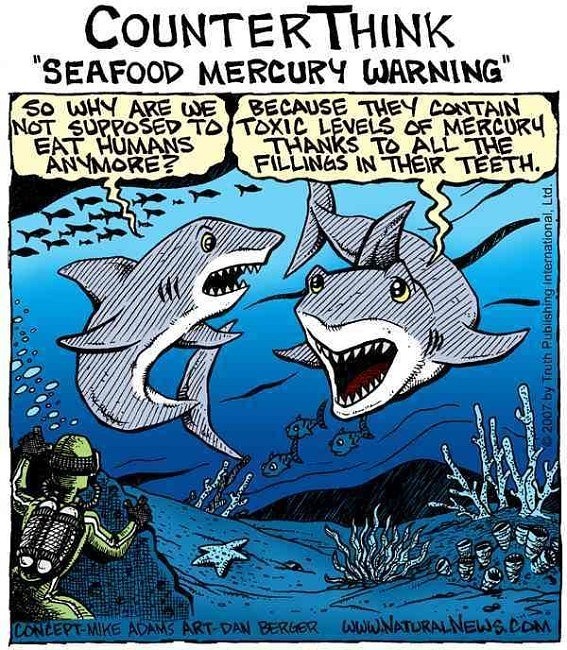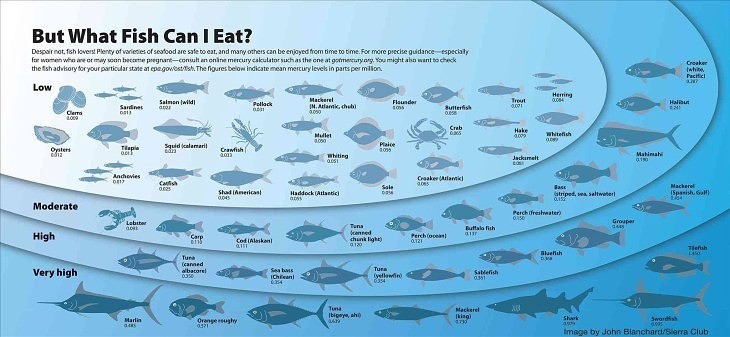Seafood & Mercury – What’s Safe To Eat & What’s Not
Mercury is an element (Hg on the periodic table) that is naturally found in our environment in the air, water, rocks and soil. Mercury can be found in several different forms: metallic mercury, inorganic mercury compounds, and organic mercury compounds.
Metallic mercury is also known as elemental mercury. At room temperatures, this form of mercury is a dazzling silver liquid. When heat is applied, metallic mercury becomes an odorless, invisible gas.
How does Mercury get into the Environment?
Mercury naturally occurs in our environment, but much more of it would be trapped in rocks beneath the surface if not for industrial processes. Coal-fired electricity generation, burning fossil fuels such as oil and natural gas, smelting, mining, and incineration of waste are the main contributors of mercury to the environment. Of these coal power plants account for over half of the mercury that ends up in our seafood. Mercury used to manufacture light bulbs, switches and thermometers also pollutes due to poor adherence with safe disposal.
The Bioaccumulation of Mercury in Its Most Toxic Form
Mercury is emitted to the air through burning coal and falls onto the ground and bodies of water usually by way of rain and snow. Several species of soil-dwelling anaerobic bacteria that take up sulfate convert inorganic mercury to methylmercury through their metabolic processes. This conversion is problematic from an ecological point of view, because methlymercury is more toxic and it takes much longer for organisms to eliminate it from their systems. Bacteria that contain methlymercury either excrete the mercury into water or organisms higher up the food chain consume the mercury-laden bacteria. Methylmercury then travels the waterways to the ocean.
Methylmercury in water travels up the food chain from being absorbed by phytoplankton. Phytoplankton is then eaten by zooplankton, small fish then eat zooplankton, and small fish get eaten by larger marine life and so on. Methlymercury accumulates in organisms faster than they can eliminate it. Animals consume and retain higher amounts of mercury each step up the food chain. This is why methlymercury is found in the highest amounts in large predatory fish such as tuna. This mercury biomagnification is most problematic for fish-eating wildlife such as dolphins and some whales and certainly poses a problem for us.
The Seafood Highest in Methylmercury
This is how Scientific American and their article How Does Mercury Get Into Fish rank the severity of mercury contamination in fish.
Highest in Mercury:
- Bluefin tuna
- Walleye
- King mackerel
- Marlin
Higher in Mercury:
- Bluefish
- Shark
- Swordfish
- Wild sturgeon
- Opah
- Bigeye tuna
Also of concern, but to a slightly lesser extent:
- Orange roughy
- Chilean sea bass
- Blue crab
- Lingcod
- Spanish mackerel
- Spotted seatrout
- Wahoo
- Grouper
- Snapper
- Halibut
- Tile fish
- Rock fish
- Sable fish
- Blackfin
- Albacore
- Yellowfin tuna
Seafood Lower In Methylmercury
We recommend consuming a variety of fish that have lower contamination levels:
- Anchovies
- Butterfish
- Catfish
- Clam
- Crab (Domestic)
- Crawfish/Crayfish
- Croaker (Atlantic)
- Flounder*

- Haddock (Atlantic)*
- Hake
- Herring
- Mackerel (N. Atlantic, Chub)
- Mullet
- Oyster
- Perch (Ocean)
- Plaice
- Pollock
- Salmon (Canned)**
- Salmon (Fresh)**
- Sardine
- Scallop*
- Shad (American)
- Shrimp*
- Sole (Pacific)
- Squid (Calamari)
- Tilapia
- Trout (Freshwater)
- Whitefish
- Whiting
Conclusion
Always make sure any seafood you consume are sustainably caught, not farm raised, and fresh (not “fishy” smelling). Include foods in your diet that naturally chelate heavy metals like cilantro, garlic, onions, brazil nuts, chlorella, and spirulina. Check out this recipe for a homemade multi-vitamin nutrition formula that chelates heavy metals. And read Detoxify from Heavy Metals and the first three sources below for more on detoxifying mercury.
Recommended Supplements:
- Shillington’s Total Nutrition Formula
- Shillington’s Intestinal Detox
- Shillington’s Blood Detox
- HM Complex – Pure Encapsulations
- Basic B Complex – Thorne Research
Further Reading:
- Top 5 Foods that Detox Heavy Metals and Toxins
- 5 Reasons to Avoid Factory-Farmed Fish
- How to Detoxify from Vaccinations & Heavy Metals
- Mercury Fillings, Root Canals, Cavitations – What You Need to Know
- Oceana Company Highlight